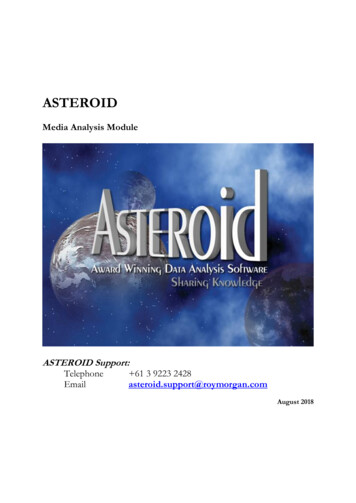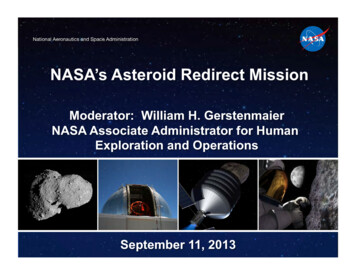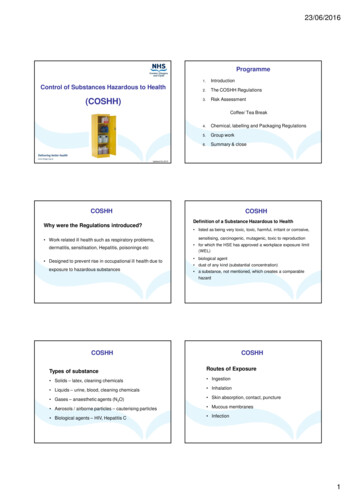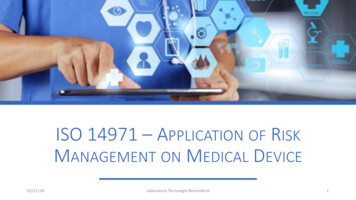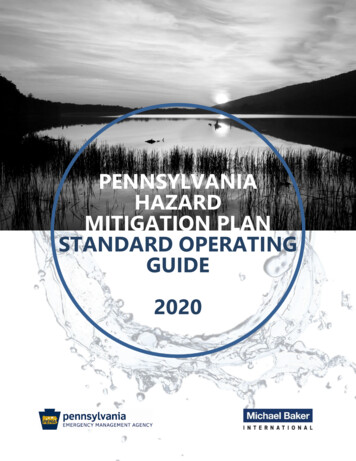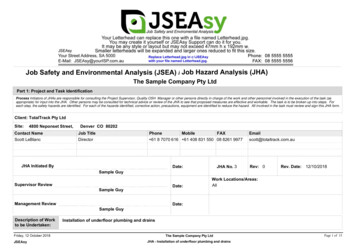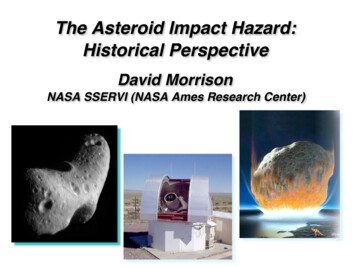
Transcription
The Asteroid Impact Hazard:Historical PerspectiveDavid MorrisonNASA SSERVI (NASA Ames Research Center)
Asteroid Grand ChallengeVirtual Seminar"NASA GRAND CHALLENGE:Find all objects capable ofthreatening humanpopulations and determinehow to deal with them.
Historical Quotes" Should a comet in its course strike the Earth, it might instantly beat it to pieces. Butour comfort is, the same great Power that made the Universe, governs it by hisprovidence. And such terrible catastrophes will not happen till 'tis best they should Benjamin Franklin (1757) Men should be free from this fear . for the probability of [a comet] striking the Earthwithin the span of a human lifetime is slim, even though the probability of such animpact occurring in the course of centuries is very great Laplace (c. 1790) Who knows whether, when a comet shall approach this globe to destroy it, as it oftenhas been and will be destroyed, men will not tear rocks from their foundations bymeans of steam, and hurl mountains, as the giants are said to have done, against theflaming mass? - and then we shall have traditions of Titans again, and of wars withHeaven. Lord Byron (1822) Civilization could be entirely destroyed by the unexpected impact of an asteroid orcomet. Thousands of years of history could be erased in a single day, and with it thehopes for future generations Clark Chapman & David Morrison (1989) If some day in the future we discover well in advance that an asteroid that is bigenough to cause a mass extinction is going to hit the Earth, and then we alter thecourse of that asteroid so that it does not hit us, it will be one of the most importantaccomplishments in all of history U.S. Congressman George Brown (1993)
Chelyabinsk, Ural Mountains, RussiaFebruary 15, 2013
Tunguska ImpactImpact in Russian SiberiaJune 1908.Destroyed more than1000 square kilometersof forestAirburst with estimatedenergy 3-6 megatonsCollision with smallstony asteroid (40 m)Predicted frequency:several centuries forentire EarthMorrison Nov 2008TunguskatodayTunguska in1929
Why Care About NEAs? " " " " "Science: Unexplored component of our solar system"Exploration: Stepping stones to Mars"Defense: Objects most likely to collide with Earth"Resources: Most accessible objects in translunar space"Politics: Of interest to President, Congress, and public"Morrison July 2007
PreludeTunguska impact in Siberia (1908)Project Icarus study of asteroid deflection (MIT 1967)KT Mass Extinction due to impact (Alvarez et al. 1980)Tom Gehrels Spacewatch: First CCD discovery of aNEO (1989)U.S. Congress asks NASA for Impact Threat Workshops(1990)Newsweek Cover Story: Doomsday Science: Comets &Asteroids and How the World Might End (1992)Economist Cover Story: The Threat from Space (1993)
NASA Workshops/Studies 1992"SPACEGUARD SURVEY WORKING GROUP (Morrison et al.) Define threshold for globally catastrophic impact Optimize survey for greatest hazard: NEAs 1 km Provide maximum warning lead time (several decades) Use existing CCD technology to be cost-effective Optimum survey covers 6000 sq deg per month to V 22 Program should be international, since entire planet is at risk
The Impact Hazard: ContextLarge cosmic impacts (by comets or asteroids) are the mostcatastrophic natural events we know (e.g., mass extinction of 65million years ago at the end of the Cretaceous). These are the mostextreme examples of a hazard with very low frequency butextremely high consequences.The contemporary risk (chances that you will die from an impact) isdominated by moderate size asteroids (1-2 km diameter). Theserisks are comparable to those of a supervolcano eruption.The impact risk can be minimized by a program to find threateningasteroids decades before they hit and develop technology todeflect them (change their orbits so they miss Earth). TheSpaceguard Survey begun in 1998 has found 95% of NEAs 1 km.The basic motivation for detection and deflection is public safety.This is a societal issue as well as a scientific one.Morrison Nov 2008
Terrestrial Impact FrequencyHiroshima(observed atmospheric impact rates)yearcenturySlope from lunarcrater countsten thousand yr.million yr.billion yr.0.01110010,000million100 millionTNT equivalent yield (MT)Morrison Oct 2007
Terrestrial Impact FrequencyHiroshimayearTunguskacenturyten thousand yr.Globalcatastrophemillion yr.K/Tbillion yr.0.01110010,000million100 millionTNT equivalent yield (MT)Morrison Oct 2007
Terrestrial Impact Frequency (Harris, . Harris inNature, 06/081100100 million10,000millionTNT equivalent yield (MT)
Overall Hazard (from 2003 STD Report)!
Torino & Palermo Hazard Scales"Torino Scale (Rick Binzel, 1999)Color-coded 10-level scale(analogous to earthquake scale)for communicating impact risk toa wide audience, based onimpact probability and energy.Palermo Scale (Steve Chesley, 2001)Technical Impact Hazard represented by a 1-dimentional logarithmicscale combining impact probability and energy into a single value,measured with respect to the background impact rate.
NEAR-Shoemaker Mission to Eros" First Mission to an NEA, first orbit, and first landing NEAR Near Earth Asteroid Rendezvous NASA Discovery MissionLaunch 1996Land 2001 Provided first in situ data Measured bulk properties,composition, mineralogy,morphology, internal massdistribution, magnetic fields,and regolith properties Discovered unexpectedgeology (boulders, ponds) Supported link between S-typeNEAs and ordinary chondrites
Hayabusa Mission to Itokawa"Launch May 2003, rendezvous andstation-keeping September 2005,extensive remote-sensing duringapproachBrief autonomous landings to collectsamples, November 2005First close-up study of sub-km NEA,revealing Itokawa as a boulder-strewnrubble pile quite different from largerNEAs such as ErosEarth return 13 June 2010. More than1000 asteroid particles recovered.
Deep Impact Hits Comet Tempel-1
Congressional Statement 1991The House Committee on Science and Technology believes that it is imperative that the detection rate of Earth-orbit-crossing asteroids must be increased substantially, and that the means to destroy or alter the orbits of asteroids when they do threaten collisions should bedefined and agreed upon internationally. The chances of theEarth being struck by a large asteroid are extremely small, butbecause the consequences of such a collision are extremelylarge, the Committee believes itis only prudent to assess thenature of the threat and prepare to deal with it.NASA Authorization Bill, 1991Morrison July 2007
Congressional Mandate 2008"The NASA Administrator shall plan,develop, and implement a Near-EarthObject Survey program to detect,track, catalogue, and characterizethe physical characteristics of nearEarth objects equal to or greater than140 meters in diameter in order toassess the threat of such near-Earthobjects to the Earth.
Assignment of Responsibility"From John Holdren (White House) to Congress (11/15/10) Any strategy for addressing the potential hazard of a NEAimpact depends in the first instance on detection,precision tracking, and characterization.NASA retains primary responsibility for discovery,tracking, and characterization, including threatidentification and notification.For mitigation of short-term threats, NASA works withHomeland Security, Department of State, and FEMA.For assessment of potential technologies for mitigation/deflection, NASA takes lead working with DoD and DHS.Recommends senior-level interagency simulationexercises, and outreach to private-sector stakeholders.Plans should involve cooperation with UN/COPUOS, EU,and ISECG.This approach is subject to further review as moreinformation becomes available.
How can we protect our planetand ourselves? The first task is to find potentially hazardousasteroids The second task is to find hazardous asteroidsand calculate their orbits The third task is to find hazardous asteroidsand calculate their orbits long before they hit.
Perspective #1: Assessing the Hazard" During the 1990s, the standard scientific tools ofsampling and statistical analysis were essential tounderstand the impact hazard and communicate the riskto decision makers. Chapman & Morrison and otherscompared the impact risk to other natural hazards,estimated the risk as a function of NEO size, and laid thefoundation for establishing the Spaceguard Survey. Congressional language (in 1991) reflected thisperspective: The Committee believes it is only prudentto assess the nature of the threat More sophisticated studies of NEA populations andimpact consequences by Harris, Chesley and otherswere used in the 2003 NASA SDT Report. Note that while these statistical studies provide a toolto analyze various mitigation schemes, they do not inthemselves reduce the hazard.
Perspective #2: Mitigating the Hazard" The public and decision-makers are interested inwarning and protection. The public-policy goal is not torefine the estimate of the risk but to identify the nextimpactor and do something about it. Changed perspective is reflected by Congress (2005):The objectives of the NEO survey program are to detect,track, catalogue, and characterize the physicalcharacteristics of NEOs (not asses risk). NEA surveys are designed to provide decades ofwarning. The objective is increased public safety, not to improvescientific understanding of either NEOs or the impactrisk, although these are worthy byproducts.
Perspective #3: Responding toPublic Concerns" Issues that worry the public (and most decisionmakers) are not necessarily the greatest threats. Thevery rare large impacts pose the greatest hazards, butmost people are more concerned about the next impact. From this perspective, it is the frequency of threatwarnings that matters, not the size of the threat. What is minimum size impactor that is a threat?Chelyabinsk was 20m, Tunguska 40m. Ideally we should design a system that detects bothdistant large NEAs and close small ones, but this dosnot seem possible, so choices must be made.
Spaceguard Survey (1998-present)NASA-funded Survey to findasteroids potentially capable ofcausing a global catastrophe,officially begun in 1998Most asteroids have beendiscovered by just 4 small (1m) telescopes with NASA andUSAF supportSpaceguard Goal: find 90% ofNEAs 1 km (but note majorityof discoveries are smaller thanthis 1-km metric)Astrometric follow-up mostly byamateurs (international)Supporting orbital analysis fromMPC, JPL NEO Program Office,U. PisaMorrison Oct 2007LINEAR telescope, New Mexico
Spaceguard Discovery Progress (1)NASA NEO Program Office, JPL
Spaceguard Discovery Progress (2) 60% 1% 1% 15%94%30
Next-Generation NEA Surveys"Surveys can be done from the ground, from Earth orbit,or from deep space.Ground-based (telescopic) surveys represent astraightforward extension of current Spaceguardtechnology. Costs are reduced by combining NEAsurvey with astrophysics objectives.For surveys from Earth, the time-scale is definedprimarily by the Earth-approach interval for NEAswith long synodic periods -- about a decade fromthe start of the survey.Space IR surveys from heliocentric orbit are faster,more complete.Any deep survey will find many more objects below thenominal target size than above.31
NEA Characterization Issues"Characterization is needed for science, defense,resource assessment, and as precursor for humanflights.How much can be done from the ground? Do we needdedicated follow-up observing facilities, such as theArecibo & Goldstone radars?Do missions need to land (trade-off with multipletargets)? What level of knowledge of interiors is needed,and are seismic or radar techniques practical? Do weneed better understanding of Yarkovsky effect?Should characterization missions be flown now, or waitfor identified threat and/or selection of deflectiontechnology?
Planetary Defense Impacts are the only natural hazardthat can, in principle, be eliminated. We could develop the technologyto change asteroid orbits. Earth moves its own diameter in 6minutes -- thus to avoid a collisionwe need only change the arrivaltime of the asteroid by 6 minutes. Technologies considered tochange orbits include ballisticimpact, gravity tractor, and nuclearexplosives. Key to any defense effort is earlydetection. Surveys are the frontline.Morrison July 2008Deep Impact, Comet Te
Defense Strategy"If an object 100 m is heading toward us, we will want todeflect it irrespective of its exact size. More complexquestions arise if it is 100 m. If such an object wereheaded for the ocean, or for an uninhabited region ofthe Earth, we would probably opt to take the hit.Given adequate warning, the simplest option bothtechnically and politically is to deflect a threatening NEAby ballistic impact.The most likely impact event in the next two decadeswill be a strike without prediction or warning. In thiscase mitigation falls to disaster-relief teams rather likethe response to a large earthquake. Internationalplanning and cooperation are required.
Issues in Planetary Defense Should we develop thistechnology now? Or wait until aspecific threat is identified? Should this be an internationaleffort? If so, how should it beorganized? How much should we spend toprotect our planet? Who can be trusted with thisresponsibility? How do we ensure that asteroiddefense systems are notmisused?Morrison July 2008
International Programs For the past decade the UN has been studyingplanetary defense through their UN Action Team onNear Earth Objects (Action Team 14) The UN Committee on the Peaceful Uses of Spacemeeting this month in Vienna approved aninternational warning network and a planningadvisory group. "It was emphasized by severalparticipants that the NEO threat concerns everyoneand international coordination and cooperation isessential in this field.” ESA/ESTEC have established a Space SituationalAwareness Program to coordinate Europeanresponses to the impact hazard.
Robust Conclusionsfrom the Hazard Analysis Cosmic impacts represent an extreme example of theclass of hazards with low probability but highconsequences.!! Unlike other natural hazards, impacts can kill billionsof people and endanger the survival of civilization.!! The total risk increases with the size (energy) of theprojectile; thus any effort at hazard reduction focusesfirst on the rare events associated with the largerimpacting bodies. There is no consensus as yet onhow to deal with smaller more frequent impacts.!! Unlike other natural catastrophes, large impacts can,in principle, be avoided by deflection to alter the orbitof the projectile.!! The initial step in any mitigation scheme is to surveythe near-Earth asteroids and determine their orbits.!
Why did Dinosaurs go Extinct? They were big and strong and beautifuland even pretty intelligent They occupied environments all over theplanet – on land and sea and air They had ruled the world for more than100 million years
Why did Dinosaurs go Extinct? They were big and strong and beautifuland even pretty intelligent They occupied environments all over theplanet – on land and sea and air They had ruled the world for more than100 million years BUT: THEY DIDN’T HAVE TELESCOPES THEY DIDN’T HAVE A SPACE PROGRAM
Asteroids are nature’sway of checking onour space program.
During the 1990s, the standard scientific tools of sampling and statistical analysis were essential to understand the impact hazard and communicate the risk to decision makers. Chapman & Morrison and others compared the impact risk to other natural hazards, estimated the risk as a function of NEO size, and laid the


